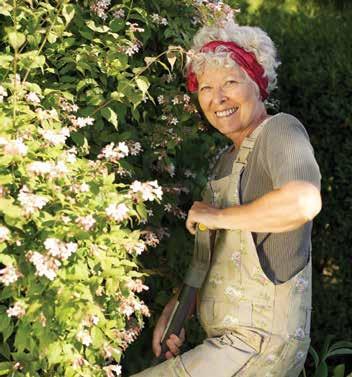
5 minute read
JOURNALLING AND WRITING
Journalling can help you identify and work through any situations in your life that are causing stress, depression or anxiety. This then allows you to create a plan for resolving any situations that may be impacting your mental health. Journalling also gives you the opportunity to practise positive self-talk and reflect on positive memories.
Creative writing is another fabulous interest to consider challenging your passions into. According to research by Scientific American, writing can help you develop your organisational skills by crafting and sequencing your thoughts and ideas, boost your reasoning and problem-solving skills, and help you to integrate a wide range of words and grow your word bank.
Advertisement
As well, because so much of the brain is engaged, the more you write, the more neural connections are formed; and the more you use your brain, the more it will grow like a muscle. You don’t have to be Ernest Hemingway or do it with a view to get published: just write for your own pleasure.
Gardening
Exposure to plants and the act of gardening can have such a positive effect on mental health. And don’t forget how good it is for your physical health: researchers found that the one common factor shared by all of the world’s centenarians was that they gardened well into their old age.


An edible garden offers the best of every world – tending it will keep you physically strong, but you can also eat what you grow, saving you money and cutting back on ingesting chemicals used to grow food. Better Health Victoria has a great guide to creating your own edible garden here: betterhealth.vic.gov.au/health/healthyliving/ gardening-for-health-starting-out.
Creating your own garden in your own backyard is optimal, but if that’s something you can’t manage, consider a house full of easy-care indoor plants, which have myriad benefits, including boosting mood, increasing creativity, reducing stress and eliminating air pollutants.
And make sure to take advantage of the country’s sublime botanical gardens: entry is free (or nominal) and you can wander for hours, finding inspiration for your own backyard or just enjoying the natural beauty and sunlight. ACG
Courtesy 7 Summit Pathways.
Personal alarms for seniors: a guide
Considering buying a personal alarm for your elderly loved one? Here’s everything you need to know.
s it time the elderly person in your care needs a personal alarm? This guide looks at the two main types – autodial alarms and monitored alarms. First, CHOICE magazine looks at the pros and cons of the former (with a caveat about their effectiveness on the next page), then we take a deep dive into monitored alarms.
AUTO-DIAL ALARMS
When a personal alarm is triggered on an auto-dial alarm, it sends an emergency alert to preset mobile phone numbers. Many personal alarms also perform other functions such as location tracking and automated location updates.
An auto-dial alarm is always on and monitors three key things: the wearer’s position using GPS any increases in speed (indicating the wearer is in a car or on public transport) sudden movements followed by no movement (indicating a possible fall).
Alarms
WHAT ARE THE DIFFERENT TYPES OF AUTO-DIAL ALARMS?
There are two basic options available: a pendant and a smartwatch.
Both pendants and watches usually have all of the communication, emergency response and tracking features mentioned above, but watches can be a bit more difficult to use due to the touch screen. At the same time, they can offer additional features you’d find in a smartwatch, such as support for thirdparty apps (see safety features, next page).
Basic pendant models have a large SOS button that’s easy to press during an emergency, as well as individual call buttons on the side. Though simple, models like this don’t have a screen to provide feedback on things such as remaining battery charge, who you’re calling, mobile signal strength and so on.

Watches can be a bit more difficult to use due to the touch screen … but offer features you’d find in a smartwatch
You can program the alarm to regularly update you with the wearer’s co-ordinates via text, or alert you if it detects an incident such as a fall, or if the wearer leaves a pre-determined area near their home. It also includes an SOS button for the wearer to press and send an immediate alert to a list of contacts you can program into the device. This SOS button can also send a text message to those contacts.
Pendant models without a screen are the easiest to use, but lack some features. Pendants with a screen are very similar to the basic model but the screen will provide some simple status updates. This can add some extra weight (usually 10-20 grams) and may reduce battery life.
Smartwatch-style alarms use a touchscreen interface and may also have a small SOS button on the side. You can often customise the appearance with a variety of watch faces, while the settings and contact menus are more detailed.
But they can be hard to use for those with limited dexterity, particularly in the event of an emergency like a fall. It’s much easier to press a big SOS button than scroll through a list of contacts. Also, the screen is typically quite small and it can be hard to read the text and tap the correct icon.
Why CHOICE won’t recommend auto-dial alarms
We are no longer recommending any auto-dial alarms on the market. We conduct real-world tests when assessing personal alarms, which are designed to replicate consumer usage during day-to-day life. But experiences are subjective, and we’ve received a number of emails from members detailing how their personal alarms were faulty or didn’t work as advertised. These complaints occurred across a number of brands and models, which we feel points to problems with the industry as a whole. choice.com.au/electronics -and-technology/gadgets/ tech-gadgets/review-andcompare/personal-alarms.
We will continue to test, score and publish personal alarm reviews so you can make an informed decision if you need to buy one for yourself or a relative. In addition to listing products that we find to perform appropriately, we’ll highlight the models you shouldn’t buy.
Buying A Personal Alarm
Almost all personal alarms are sold online, or through small businesses specialising in aged care. However, you may find that nursing homes, hospitals and senior community groups have partnerships with brands.
Prices range from $140 up to almost $500, which may not include the price of the SIM card or optional subscription service.
However, you might be able to get a personal alarm from the government, if you meet assessment requirements. The Commonwealth Home Support program provides government support for individuals who need access to services and financial assistance required for independent living as they age.
The National Disability Insurance Scheme
(NDIS) can also provide funding, while veterans might be able to receive support through their own government programs. Community services and even manufacturers may offer financial support and solutions as well, though this varies and tends to exist on a case-by-case basis. Check with your health fund, too.
WHICH TYPE IS BEST?
This depends on a number of physical and mental health factors, so please understand that this advice is a broad starting point. It’s best to consult with the wearer’s GP first.
If the wearer is in a good physical and mental state but wants a personal alarm for peace of mind, then a pendant or touchscreen watch will be fine. A model with GPS is also worth looking into if the wearer is often out and about by themselves, as this will allow you to pinpoint their location if something





